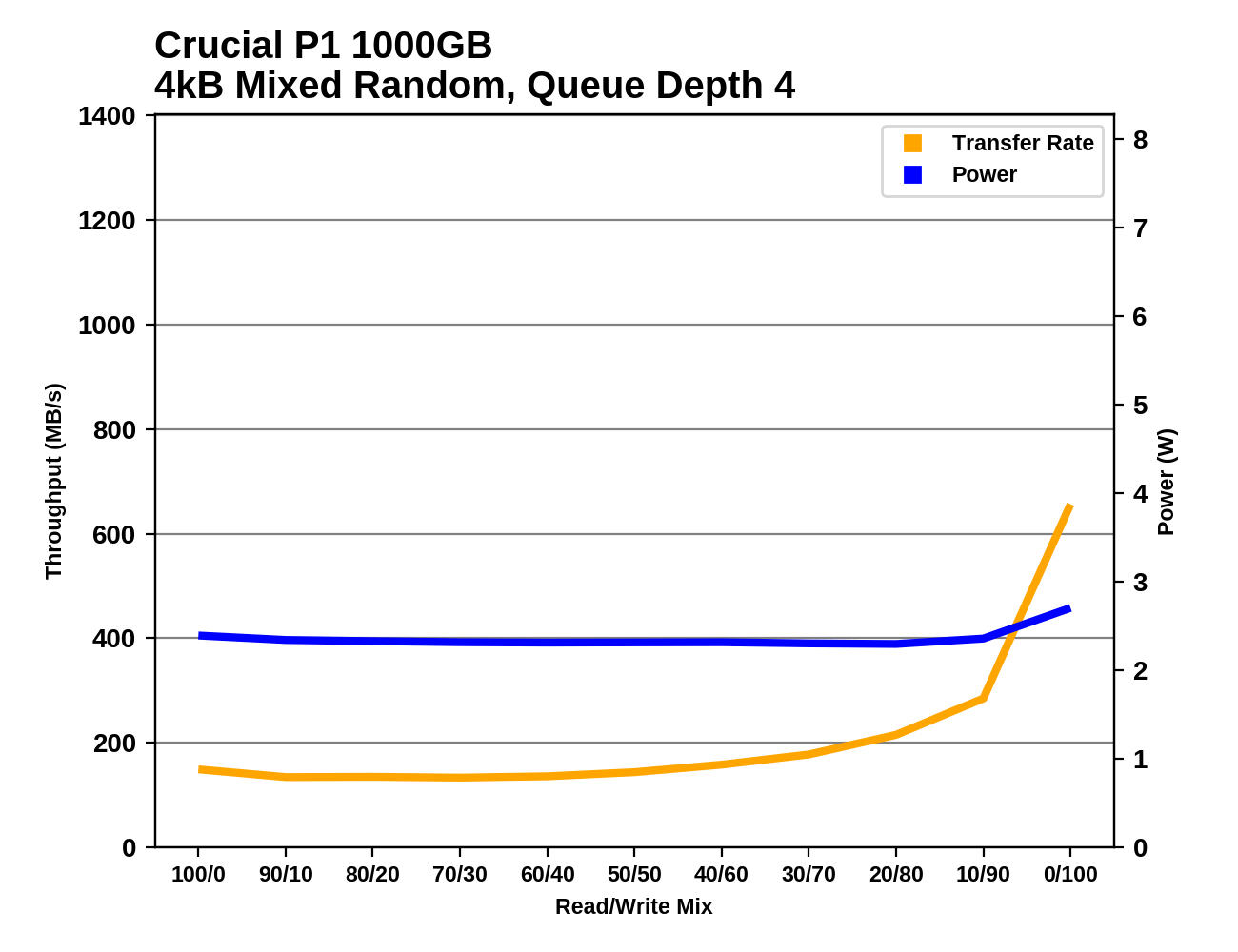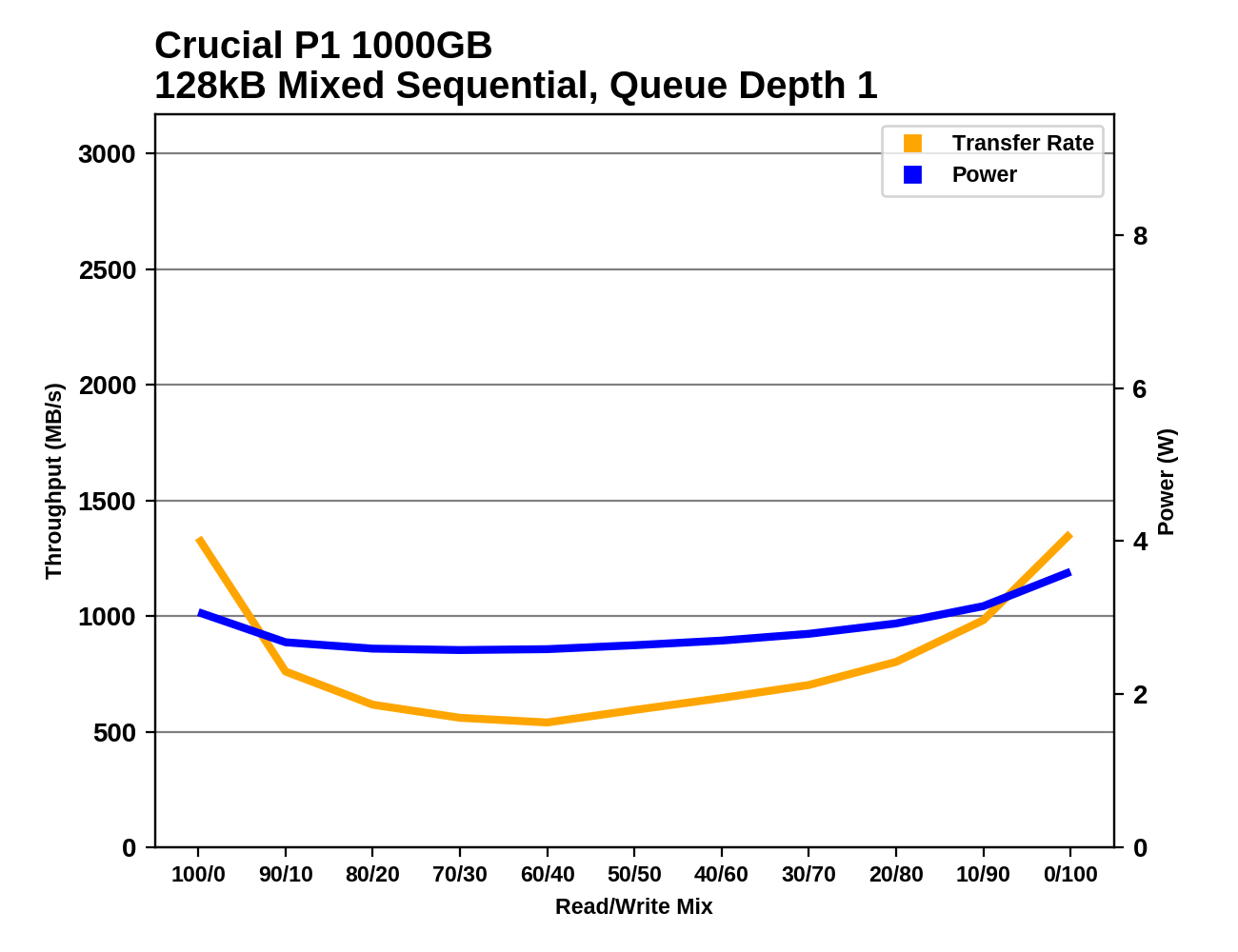The Crucial P1 1TB SSD Review: The Other Consumer QLC SSD
by Billy Tallis on November 8, 2018 9:00 AM ESTMixed Random Performance
Our test of mixed random reads and writes covers mixes varying from pure reads to pure writes at 10% increments. Each mix is tested for up to 1 minute or 32GB of data transferred. The test is conducted with a queue depth of 4, and is limited to a 64GB span of the drive. In between each mix, the drive is given idle time of up to one minute so that the overall duty cycle is 50%.

The Crucial P1 has reasonable entry-level NVMe performance on the mixed random I/O test. It's clearly faster than the MX500 SATA SSD and comes close to some high-end NVMe SSDs. But when the drive is full and the SLC cache is at its minimum size, the P1 slows down to 40% of its speed on a drive containing only the test data. When full, the P1 is about 22% slower than the Intel 660p, but their empty-drive performance is similar.
 |
|||||||||
| Power Efficiency in MB/s/W | Average Power in W | ||||||||
The Crucial P1 has worse power efficiency than the Intel 660p on this test, whether it is run on a full drive or not. The efficiency is still reasonable for the mostly-empty drive test run, but when full the P1's power consumption increases slightly and the efficiency is significantly worse than other low-end NVMe SSDs.
 |
|||||||||
When the mixed random I/O test is run on a full Crucial P1, the benefits of the SLC cache almost completely disappear, leaving the drive with a mostly flat performance curve (with some inconsistency) rather than the significant performance upswing as the proportion of writes grows beyond 70%. The Intel 660p's performance is very similar save for slightly lower write performance to the SLC cache, and slightly improved full-drive performance.
Mixed Sequential Performance
Our test of mixed sequential reads and writes differs from the mixed random I/O test by performing 128kB sequential accesses rather than 4kB accesses at random locations, and the sequential test is conducted at queue depth 1. The range of mixes tested is the same, and the timing and limits on data transfers are also the same as above.

The performance of the Crucial P1 on the mixed sequential I/O test is better than most entry-level NVMe SSDs and comes close to some of the slower high-end drives. Even when the test is run on a full drive, the P1 remains faster than SATA SSDs, and its full-drive performance is slightly better than the Intel 660p.
 |
|||||||||
| Power Efficiency in MB/s/W | Average Power in W | ||||||||
The power efficiency of the Crucial P1 on this test is about average for an entry-level NVMe drive. When the test is run on a full drive, the reduced performance causes efficiency to take a big hit, but it ends up being only slightly less efficient than the Crucial MX500 SATA SSD.
 |
|||||||||
The Crucial P1 has decent performance at either end of the test, when the workload is either very read-heavy or very write-heavy. Compared to other entry-level NVMe drives, the P1 starts out with better read performance and recovers more of its performance toward the end of the test than many of its competitors. The minimum reached at around a 60/40 read/write split is faster than a SATA drive can manage but is unremarkable among NVMe drives. When the test is run on a full drive, performance during the more read-heavy half of the test is only slightly reduced, but things get worse throughout the write-heavy half of the test instead of improving as write caching comes more into play.










66 Comments
View All Comments
DigitalFreak - Thursday, November 8, 2018 - link
At this rate, by the time they get to H(ex)LC you'll only be able to write 1GB per day to your drive or risk having it fail.PeachNCream - Thursday, November 8, 2018 - link
Please don't give them any ideas! The last thing we need is NAND that generously handles a few dozen P/E cycles before dying. We've already gone from millions of P/E cycles to a few hundred in the last 15 years and data retention has dropped from over a decade to under six months. Sure you can get a lot more capacity for the price, but NAND needs to be replaced with something more durable sooner rather than later. (And no, I'm not advocating for Optane either, just something that lasts longer and has room for density improvements - don't care what that something is.)MrCommunistGen - Thursday, November 8, 2018 - link
I was expecting the extra DRAM to provide a more meaningful advantage over the Intel 660p... I guess it makes sense that Intel left it off to save on BOM.Ratman6161 - Thursday, November 8, 2018 - link
This could be a very good standard desktop drive if 1) the price is right and 2) you can accept that the 1 TB drive is really only good for up to 900 GB. You would just partition the drive such that there is 100 GB free (or make sure you always just keep that much space free) so you always have the maximum SLC cach available. For the price to be right, it has to be lower. Taking the prices from the article, the 1 TB P1 is only $8 cheaper than a 970 EVO. Now if they could get the price down to the same territory as the current MX 500 they might have something.Billy Tallis - Thursday, November 8, 2018 - link
Leaving 10% of the drive unpartitioned won't be enough to get the maximum size SLC cache, because 1GB of SLC cache requires 4GB of QLC to be used as SLC. However, 10% manual overprovisioning would definitely reduce the already small chances of overflowing the SLC cache.mczak - Thursday, November 8, 2018 - link
On that note, wouldn't it actually make sense to use a MLC cache instead of a SLC cache for these SSDs using QLC flash (and by MLC of course I mean using 2 bits per cell)? I'd assume you should still be able to get very decent write speeds with that, and it would effectively only need half as much flash for the same cache size.Billy Tallis - Thursday, November 8, 2018 - link
Cache size isn't really a big enough problem for a 2bpc MLC write cache to be worthwhile. Using SLC for the write cache has several advantages: highest performance/lowest latency, single-pass reads and writes (important for Crucial's power loss immunity features), and your SLC cache can use flash blocks that are too worn out to still reliably store multiple bits per cell. A slower write cache with twice the capacity would only make sense if consumer workloads regularly overflowed the existing write cache. Almost all of the instances where our benchmarks overflow SLC caches are a consequence of our tests giving the drive less idle time than real-world usage, rather than being tests representing use cases where the cache would be expected to overflow even in the real world.idri - Thursday, November 8, 2018 - link
Why don't you guys include the Samsung 970 PRO 1TB in your charts for comparison? It's one of the most sought after SSDs on the market for HEDT systems and for sure it would be useful to have your tests results for this one too. Thanks.Billy Tallis - Thursday, November 8, 2018 - link
A.) Samsung didn't send me a 970 PRO. B.) The 970 PRO is pretty far outside the range of what could be considered competition for an entry-level NVMe SSD. It's a drive you buy for bragging rights, not for real-world performance benefits. The Optane SSD is in that same category, and I don't think the graphs for this kind of review need to be cluttered up with too many of those.PeachNCream - Thursday, November 8, 2018 - link
Not to be obtuse, but by price the 970 PRO is well within the range of competition for the P1 given that the 1TB 970 retails for $228 on Amazon right now and the MSRP for the 1TB P1 $220. Buyers looking for a product will most certainly consider the $8 difference and factor that into their decision to move up from an entry-level product to a "bragging rights" option given the insignificant difference in cost. Your first point is valid. I would have stopped there since its reasonable to say, "Physically impossible, don't have one there pal."